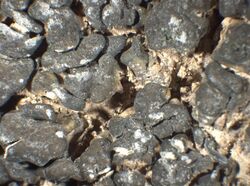Biology:Gloeoheppiaceae
| Gloeoheppiaceae | |
|---|---|

| |
| Gloeoheppia turgida | |
| Scientific classification Error creating thumbnail: Unable to save thumbnail to destination
| |
| Domain: | Eukaryota |
| Kingdom: | Fungi |
| Division: | Ascomycota |
| Class: | Lichinomycetes |
| Order: | Lichinales |
| Family: | Gloeoheppiaceae Henssen (1995) |
| Genera | |
|
Gloeoheppia | |
Gloeoheppiaceae is a family of ascomycete fungi in the order Lichinales.[1][2] The family contains ten species distributed amongst three genera. Most species are lichenised with cyanobacteria. Species in this family are mostly found in desert areas.[3] Modern molecular phylogenetics analysis casts doubt on the phylogenetic validity of the family, suggesting a more appropriate placement of its species in the family Lichinaceae.
Taxonomy
The family was circumscribed in 1995 by the German lichenologist Aino Henssen. Her research corroborated the findings of Marton & Galun (1981) and provided additional support for the distinction between the genera Gloeoheppia and Heppia, initially suggested by Vilmos Kőfaragó-Gyelnik in 1935.[4] Henssen observed that the unique paraphyses of Heppia, with a base comprising short cells, align closely with characteristics found in genera of the family Coccocarpiaceae. This is further evidenced by the presence of thick [[Glossary of lichen terms#{{biology:{1}}}|{{Biology:{1}}}]] (female reproductive structures), [[Glossary of lichen terms#{{biology:{1}}}|{{Biology:{1}}}]] (long, slender organs in female gametangia), and thallus hyphae, as well as by its attachment to substrates via single rhizoidal hyphae, a feature common to members of the families Collemataceae or Placynthiaceae. Conversely, in Gloeoheppia, the development of apothecia (fruiting bodies) and the overall structure of the thallus bear a closer resemblance to those found in the family Lichinaceae, marking a distinct differentiation from Heppia.[5]
In molecular phylogenetics analysis published in 2021, Díaz-Escandón and colleagues show that the Gloeoheppiaceae was recovered in a highly supported clade with Lichina and Lichinella (both genera members of the family Lichinaceae), and that in their analysis the three families of Lichinales recognized in the current literature are not recovered. They suggest that "support in particular for the family Gloeoheppiaceae ... does not appear to be forthcoming".[6]
Description
The Gloeoheppiaceae consists of lichen-forming fungi with a [[Glossary of lichen terms#{{biology:{1}}}|{{Biology:{1}}}]] to [[Glossary of lichen terms#{{biology:{1}}}|{{Biology:{1}}}]] (shield-like) thallus, which is [[Glossary of lichen terms#{{biology:{1}}}|{{Biology:{1}}}]], meaning its internal structure is uniform throughout. The family's [[Glossary of lichen terms#{{biology:{1}}}|{{Biology:{1}}}]] (photosynthetic partner) is cyanobacterial, typically of the chroococcoid type. As for reproductive structures, the ascomata (fruiting bodies) are apotheciate and [[Glossary of lichen terms#{{biology:{1}}}|{{Biology:{1}}}]], meaning they are disc-like and often sunken or closely attached to the thallus. The [[Glossary of lichen terms#{{biology:{1}}}|{{Biology:{1}}}]], the tissue layer containing fertile parts of the ascomata, comprises paraphyses that are either unbranched or branched and can be amyloid (staining with iodine) or non-amyloid. The asci, which are the spore-bearing cells, are prototunicate and non-amyloid, indicating a simple, undifferentiated wall. The [[Glossary of lichen terms#{{biology:{1}}}|{{Biology:{1}}}]] are straightforward in form: [[Glossary of lichen terms#{{biology:{1}}}|{{Biology:{1}}}]], ellipsoid, hyaline (translucent), and non-amyloid. For asexual reproduction, Gloeoheppiaceae have conidiomata (structures producing asexual spores) known as pycnidia, with non-septate, [[Glossary of lichen terms#{{biology:{1}}}|{{Biology:{1}}}]] (rod-shaped), hyaline conidia. No secondary metabolites have been identified in this family.[7]
Genera and species
(As of December 2023), Species Fungorum (in the Catalogue of Life) accept three genera and ten species in the family Gloeoheppiaceae:[1]
- Gloeoheppia Gyeln. (1935)[4]
- Gloeoheppia erosa
- Gloeoheppia polyspora
- Gloeoheppia rugosa
- Gloeoheppia squamulosa
- Gloeoheppia turgida
- Gudelia Henssen (1995)
- Gudelia mexicana
- Pseudopeltula Henssen (1995)
- Pseudopeltula dicyanophora
- Pseudopeltula heppioides
- Pseudopeltula myriocarpa
- Pseudopeltula necrocorticata
Habitat and distribution
Members of the Gloeoheppiaceae are either terricolous (ground-dwelling) or saxicolous (rock-dwelling), and tend to prefer growing on [[Glossary of lichen terms#{{biology:{1}}}|{{Biology:{1}}}]] that are calciferous. They are generally found in dry subtropical areas or regions with a Mediterranean climate.[7]
References
- ↑ 1.0 1.1 "Gloeoheppiaceae". Species 2000: Naturalis, Leiden, the Netherlands. https://www.catalogueoflife.org/data/taxon/Gloeoheppiaceae.
- ↑ Wijayawardene, N.N.; Hyde, K.D.; Dai, D.Q.; Sánchez-García, M.; Goto, B.T.; Saxena, R.K. et al. (2022). "Outline of Fungi and fungus-like taxa – 2021". Mycosphere 13 (1): 53–453 [180]. doi:10.5943/mycosphere/13/1/2. https://www.researchgate.net/publication/358798332.
- ↑ Fungal Families of the World. Wallingford: CABI. 2007. pp. 17. ISBN 0-85199-827-5.
- ↑ 4.0 4.1 Gyelnik, V. (1935). "De familiam Heppiacearum 1,2" (in de). Feddes Repertorium 38: 153–157 (465–469), 307–313 (523–529).
- ↑ Henssen, Aino (1995). "The New Lichen family Gloeoheppiaceae and its genera Gloeoheppia, Pseudopeltula and Gudelia (Lichinales)". The Lichenologist 27 (4): 261–290. doi:10.1006/lich.1995.0025.
- ↑ Díaz-Escandón, David; Hawksworth, David L.; Powell, Mark; Resl, Philipp; Spribille, Toby (2021). "The British chalk specialist Lecidea lichenicola auct. revealed as a new genus of Lichinomycetes". Fungal Biology 125 (7): 495–504. doi:10.1016/j.funbio.2021.01.007.
- ↑ 7.0 7.1 Jaklitsch, Walter; Baral, Hans-Otto; Lücking, Robert; Lumbsch, H. Thorsten (2016). Syllabus of Plant Families: Adolf Engler's Syllabus der Pflanzenfamilien. 1/2 (13 ed.). Berlin Stuttgart: Gebr. Borntraeger Verlagsbuchhandlung, Borntraeger Science Publishers. p. 205. ISBN 978-3-443-01089-8. OCLC 429208213.
Wikidata ☰ Q5571168 entry
 |

